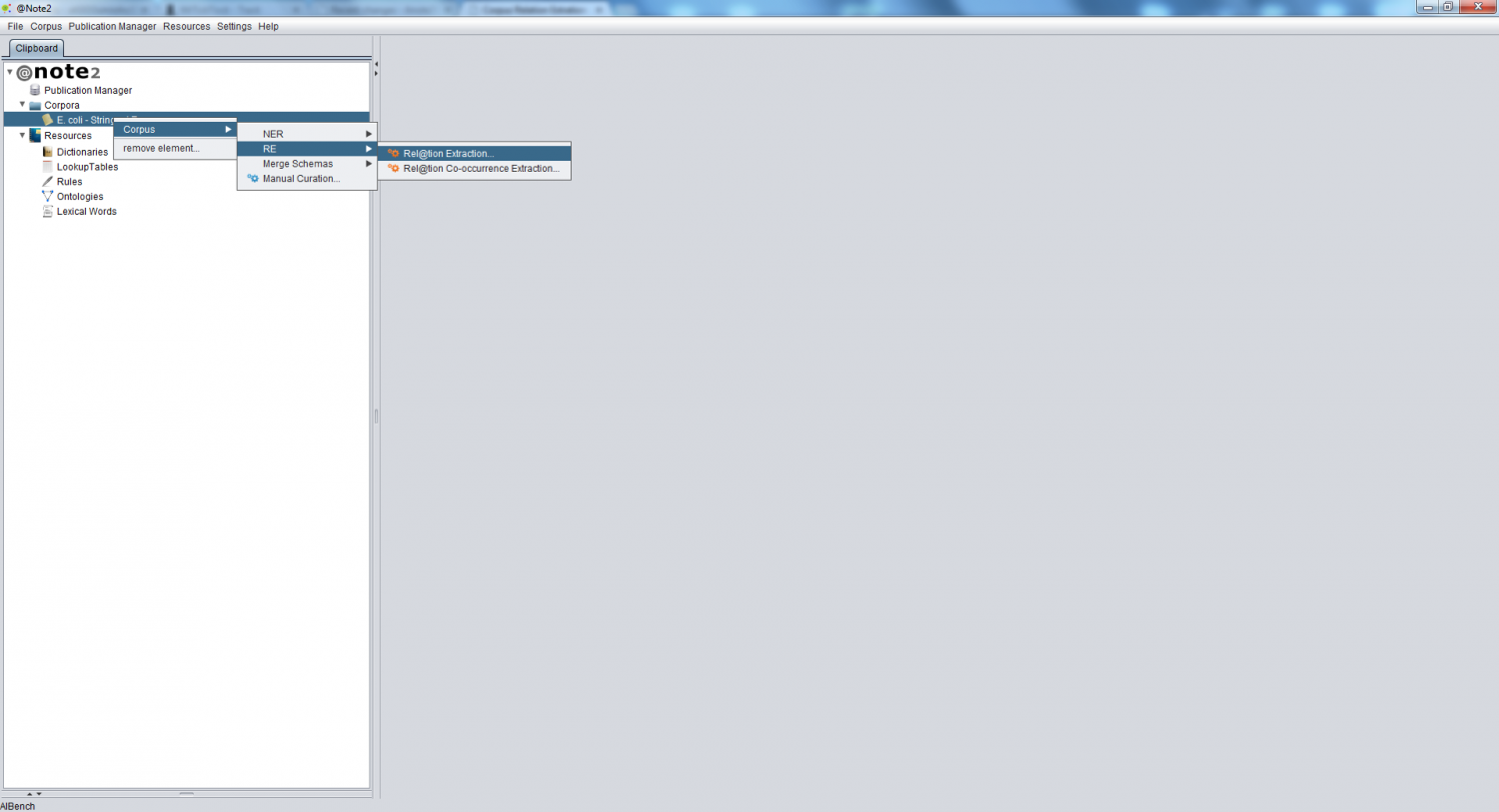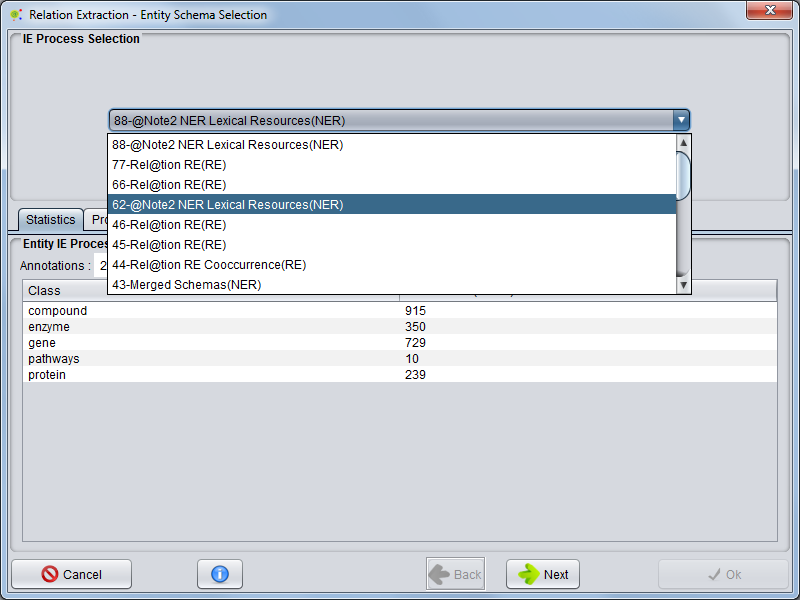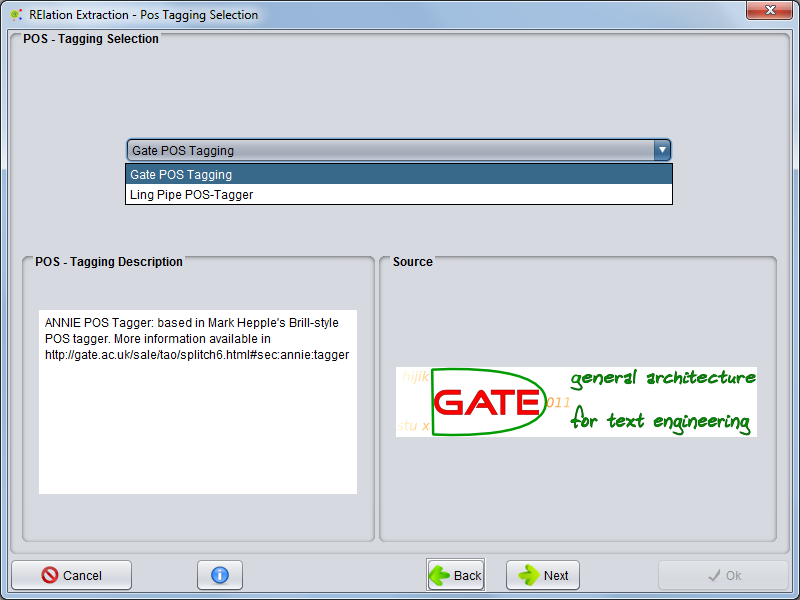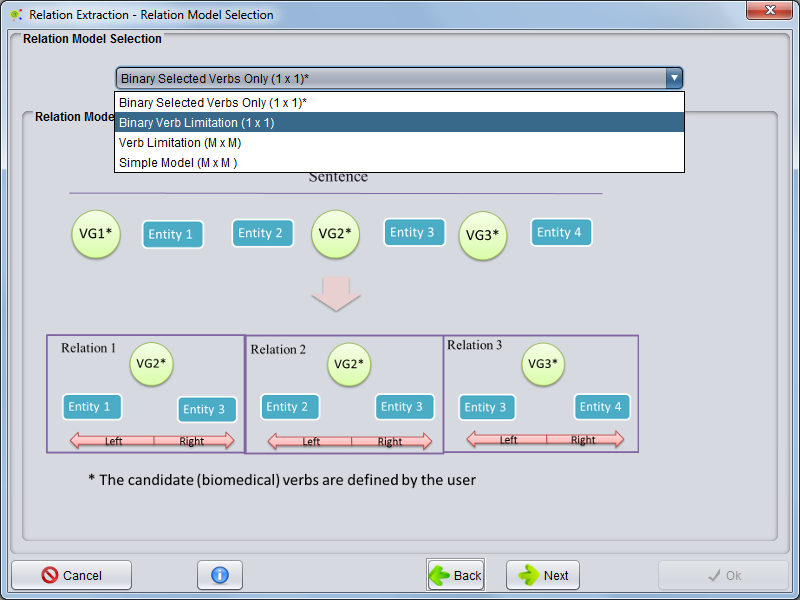Difference between revisions of "Corpus Relation Extraction"
| Line 1: | Line 1: | ||
| + | __TOC__ | ||
[[Category:HOWTOs]] | [[Category:HOWTOs]] | ||
| + | == Operation == | ||
To perform a '''Relation Extraction''' (RE) process based in Natutal Language Processing algorithms, you should right click a Corpus data-type object and select the option '''Corpus -> RE-> Relation Extraction'''. | To perform a '''Relation Extraction''' (RE) process based in Natutal Language Processing algorithms, you should right click a Corpus data-type object and select the option '''Corpus -> RE-> Relation Extraction'''. | ||
If the Corpus is not in the clipboard, you should begin by [[Corpora_Load_Corpus|loading the Corpus to the Clipboard]]. | If the Corpus is not in the clipboard, you should begin by [[Corpora_Load_Corpus|loading the Corpus to the Clipboard]]. | ||
| Line 9: | Line 11: | ||
A new wizard is presented that allows to configure the RE process. | A new wizard is presented that allows to configure the RE process. | ||
| + | |||
| + | == Entity Process Selection == | ||
The first panel enables the '''selection''' of the '''processes''' that contain the entities annotated, allowing to view some statistics and process properties. After selecting the process press '''Next''' to continue. | The first panel enables the '''selection''' of the '''processes''' that contain the entities annotated, allowing to view some statistics and process properties. After selecting the process press '''Next''' to continue. | ||
| Line 14: | Line 18: | ||
[[Image:RE1.png|800px|center]] | [[Image:RE1.png|800px|center]] | ||
| − | + | == POS-Tagger selection == | |
The next panel allows for '''POS-Tagger selection'''. Here, you select which POS-Tagger will be used, and some information about its origin and properties will be presented. After choosing the desired POS-Tagger press '''Next''' to continue. | The next panel allows for '''POS-Tagger selection'''. Here, you select which POS-Tagger will be used, and some information about its origin and properties will be presented. After choosing the desired POS-Tagger press '''Next''' to continue. | ||
| Line 20: | Line 24: | ||
[[Image:RE2.png|800px|center]] | [[Image:RE2.png|800px|center]] | ||
| − | + | == Relation Extraction Model Selection == | |
The following panel allows for '''Relation Extraction Model Selection'''. Select the most adequate model (the panel below shows the expected type of results). After selecting the best model press '''Next'''. | The following panel allows for '''Relation Extraction Model Selection'''. Select the most adequate model (the panel below shows the expected type of results). After selecting the best model press '''Next'''. | ||
| Line 26: | Line 30: | ||
[[Image:RE3.png|800px|center]] | [[Image:RE3.png|800px|center]] | ||
| − | + | == Verb List Filter == | |
The next panel allows choosing if a '''Verb List''' will be used to filter the results and define this list. You can select a list of verbs (a Lexical Words object) that will not be used to create relations Typically, this will be used to avoid relations with common English verbs (e.g. be, do). | The next panel allows choosing if a '''Verb List''' will be used to filter the results and define this list. You can select a list of verbs (a Lexical Words object) that will not be used to create relations Typically, this will be used to avoid relations with common English verbs (e.g. be, do). | ||
| Line 32: | Line 36: | ||
[[Image:RE4.png|800px|center]] | [[Image:RE4.png|800px|center]] | ||
| − | + | == Verb List Added == | |
The next panel allows choosing an additional '''Verb List'''. You can select a list of verbs (a Lexical Words object) to add as relation clues, i.e. they provide a complement to the verbs list used internally by @Note. | The next panel allows choosing an additional '''Verb List'''. You can select a list of verbs (a Lexical Words object) to add as relation clues, i.e. they provide a complement to the verbs list used internally by @Note. | ||
Once this option is selected, press '''Ok'''. | Once this option is selected, press '''Ok'''. | ||
| Line 39: | Line 43: | ||
[[Image:RE5.png|800px|center]] | [[Image:RE5.png|800px|center]] | ||
| − | + | == Result == | |
The RE operation will start and a progress window is shown, indicating the execution of the operation. The RE operation will take a few minutes or hours, depending on corpus size. | The RE operation will start and a progress window is shown, indicating the execution of the operation. The RE operation will take a few minutes or hours, depending on corpus size. | ||
When the process ends, a new '''RE Process''' object will be added to the [[Corpus_Load_Process|''Corpus Process View'']]. | When the process ends, a new '''RE Process''' object will be added to the [[Corpus_Load_Process|''Corpus Process View'']]. | ||
Revision as of 18:50, 23 January 2013
Contents
Operation
To perform a Relation Extraction (RE) process based in Natutal Language Processing algorithms, you should right click a Corpus data-type object and select the option Corpus -> RE-> Relation Extraction. If the Corpus is not in the clipboard, you should begin by loading the Corpus to the Clipboard.
A new wizard is presented that allows to configure the RE process.
Entity Process Selection
The first panel enables the selection of the processes that contain the entities annotated, allowing to view some statistics and process properties. After selecting the process press Next to continue.
POS-Tagger selection
The next panel allows for POS-Tagger selection. Here, you select which POS-Tagger will be used, and some information about its origin and properties will be presented. After choosing the desired POS-Tagger press Next to continue.
Relation Extraction Model Selection
The following panel allows for Relation Extraction Model Selection. Select the most adequate model (the panel below shows the expected type of results). After selecting the best model press Next.
Verb List Filter
The next panel allows choosing if a Verb List will be used to filter the results and define this list. You can select a list of verbs (a Lexical Words object) that will not be used to create relations Typically, this will be used to avoid relations with common English verbs (e.g. be, do).
Verb List Added
The next panel allows choosing an additional Verb List. You can select a list of verbs (a Lexical Words object) to add as relation clues, i.e. they provide a complement to the verbs list used internally by @Note. Once this option is selected, press Ok.
Result
The RE operation will start and a progress window is shown, indicating the execution of the operation. The RE operation will take a few minutes or hours, depending on corpus size.
When the process ends, a new RE Process object will be added to the Corpus Process View.





